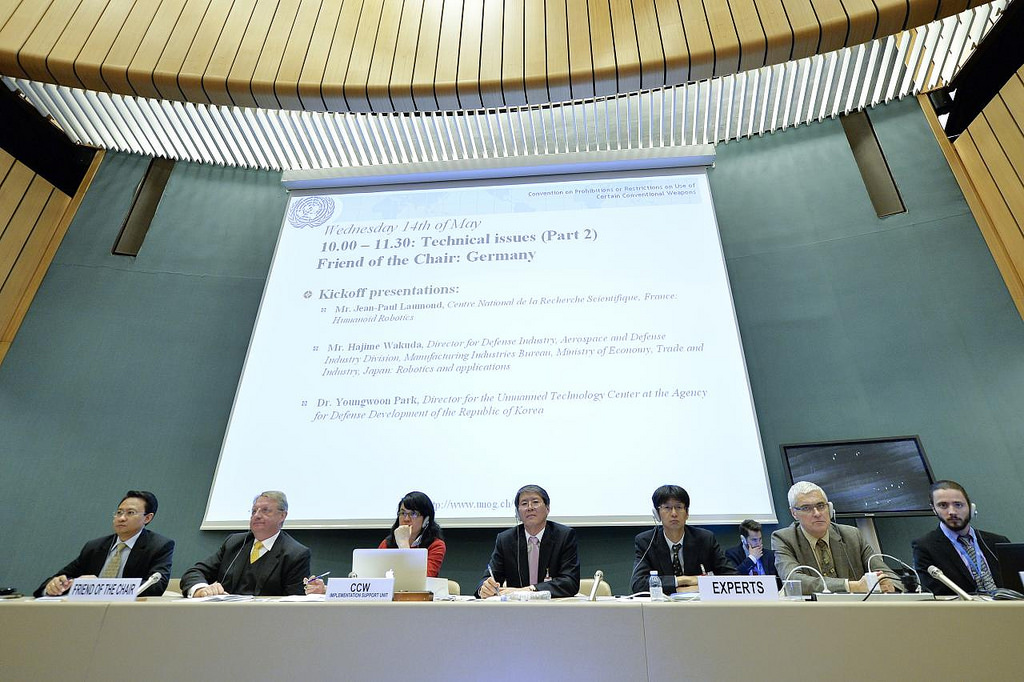
2014: A year of progress

The first-ever multilateral meeting held earlier this year on “lethal autonomous weapons systems” marked a key milestone for the Campaign to Stop Killer Robots, while the consensus agreement by nations to hold another meeting at the Convention on Conventional Weapons (CCW) on 13-17 April 2015 confirms the matter is now firmly on the international agenda and unlikely to disappear anytime soon.
Yet how fast the “informal meetings of experts” progress to a more substantive process depends on how swiftly governments develop and articulate their national policy on these weapons that would select and attack targets without further human intervention. How far any process goes is also highly dependent on whether nations embrace a preemptive ban on development, production and use of fully autonomous weapons.
Spurred on by the campaign’s non-governmental organizations (NGOs) as well as by think tanks and academics, 2014 saw notable diplomatic progress and increased awareness in capitals around the world of the challenges posed by autonomous warfare, but there were few signals that national policy is any closer to being developed. Only two nations have stated policy on autonomous weapons systems: a 2012 US Department of Defense directive permits the development and use of fully autonomous systems that deliver only non-lethal force, while the UK Ministry of Defence has stated that it has “no plans to replace skilled military personnel with fully autonomous systems.”
Five nations—Cuba, Ecuador, Egypt, Pakistan, and the Holy See—have expressed support for the objective of a preemptive ban on fully autonomous weapons, but have yet to execute that commitment in law or policy. A number of nations have indicated support for the principle of human control over the selection of targets and use of force, indicating they see a need to draw the line at some point.
Policy development by governments will come only if civil society demands it and the Campaign to Stop Killer Robots remains the only civil society coalition tackling these weapons head on. With more than 50 member NGOs in more than two dozen countries, the campaign is working to encourage government support and stimulate public interest in its objective of a preemptive ban on fully autonomous weapons.
This post explores some of this year’s highlights and activities undertaken by the Campaign to Stop Killer Robots.
The year opened with a resolution by the European Parliament on 27 February on the use of armed drones that included a call to “ban the development, production and use of fully autonomous weapons which enable strikes to be carried out without human intervention.” Sponsored by the Greens/European Free Alliance group of Members of the European Parliament with cross-party support, the resolution was adopted by a vote of 534–49.
A number of consultations and meetings took place in the lead-up to the CCW experts meeting, including the first Chatham House conference on autonomous military technologies in London on 24-25 February and the first International Committee of the Red Cross (ICRC) experts meeting on autonomous weapons systems in Geneva on 26-28 March, attended by representatives from 21 states. The campaign’s coordinator Mary Wareham of Human Rights Watch addressed a Stimson Center roundtable with Japan, Turkey, and Poland on the next generation of weapons threats in New York on 26 March.
The first informal CCW meeting of experts held at the United Nations (UN) in Geneva on 13-16 May attracted “record attendance” with the participation of 86 states, UN agencies, the ICRC, and the Campaign to Stop Killer Robots. The campaign’s delegation contributed actively throughout the meeting, making statements in plenary, issuing briefing papers and reports, hosting four consecutive side events, and briefing media throughout. The chair and vice-chair of the International Committee for Robot Arms Control (ICRAC) gave expert presentations at the meeting, which ICRAC had urged be convened since 2009.
The 2014 experts meeting reviewed technical, legal, ethical, and operational questions relating to the emerging technology of lethal autonomous weapons systems, but did not take any decisions. Ambassador Jean-Hugues Simon-Michel of France provided a report of the meeting in his capacity as chair that summarized the main areas of interest and recommended further talks in 2015.
The report notes how experts and delegations described the potential for autonomous weapons systems to be “game changers” in military affairs, but observed there appeared to be little military interest in deploying fully autonomous weapons systems because of the need to retain human control and concerns over operational risks including vulnerability to cyber attacks, lack of predictability, difficulties of adapting to a complex environment, and challenges of interoperability. Delegates also considered proliferation and the potential impact of autonomous weapons on international peace and security.
Delegates considered the impact of development of autonomous weapons systems on human dignity, highlighting the devolution of life and death decisions to a machine as a key ethical concern. Some asked if a machine could acquire capacities of moral reasoning and human judgment, which is the basis for respect of international humanitarian law principles and challenged the capacity of machine to respond to a moral dilemma.
There was acknowledgment that international humanitarian and human rights law applies to all new weapons but views were divided as to whether the weapons would be illegal under existing law or permitted in certain circumstances. The imperative of maintaining meaningful human control over targeting and attack decisions emerged as the primary point of common ground at the meeting.
One disappointing aspect of the otherwise successful meeting was the lack of any women experts in the meeting’s line-up of 18 expert presenters. Campaign co-founder the Women’s International League for Peace and Freedom (WILPF) convened a caucus of campaign women to strategize on overcoming the lack of gender diversity on this topic. Resulting initiatives include the no “manpanels” initiative by campaign co-founder Article 36, which lists men who have pledged not to speak on all-male panels on humanitarian disarmament topics such as killer robots.
The 2014 experts meeting concentrated on the role played by autonomous weapons systems in situations of armed conflict in part because their possible use in law enforcement and other situations is seen as a matter better suited to the Human Rights Council. 2014 saw the release of José Padilha’s remake of the popular film Robocop and two new publications that scrutinize the risks of using autonomous weapons in policing.
Both the Shaking the Foundation: The Human Rights Implications of Killer Robots report issued in May by Human Rights Watch and Harvard Law School’s International Human Rights Clinic and a June report by the UN Special Rapporteur on extrajudicial, summary or arbitrary executions, Professor Christof Heyns, find that autonomous weapons systems pose far-reaching potential implications to human rights, specifically the rights to life and dignity. The report by Heyns, who addressed the 2014 experts meeting and issued a 2013 report calling for a moratorium on autonomous weapons systems, recommends that the Human Rights Council “remain seized” with the issue and “make its voice heard as the international debate unfolds.”
The Campaign to Stop Killer Robots mapped out its plans for the year at a strategy meeting in London on 26-27 February, including objectives for the CCW and Human Rights Council. During the year, campaigners undertook national actions on killer robots–including public briefings and parliamentary outreach–for the first time in Canada, Ireland, Italy, Japan, New Zealand, Netherlands, Norway, Sweden, the United States.
2014 saw the first private sector initiative in support of the Campaign to Stop Killer Robots when Canadian company Clearpath Robotics issued a statement on 13 August pledging not to participate in the development of fully autonomous weapons. The move attracted significant media interest and one of the company’s founders, Ryan Gariepy, subsequently spoke to governments and campaigners in New York in October during the annual UN General Assembly First Committee on Disarmament and International Security.
In May, more than 20 Nobel Peace Laureates issued a joint statement endorsing the call to pre-emptively ban killer robots that Ms. Jody Williams of the Nobel Women’s Initiative, a campaign co-founder, delivered to the CCW meeting. A declaration issued by the Nobel Peace Laureates at their Rome summit in December states, “we support the call for a pre-emptive ban on fully autonomous weapons (killer robots) – weapons that would be able to select and attack targets without human intervention” and urges, “we must prevent this new form of inhumane warfare.”
In November, more than 70 faith leaders of various denominations, including Archbishop Desmond Tutu of South Africa, endorsed an interfaith call to action against fully autonomous weapons. The signatures were collected by campaign co-founder PAX (formerly IKV Pax Christi), which issued a report earlier in 2014 detailing its concerns with killer robots as well as a brief animation film.
Campaign representatives continued to brief the UN Secretary-General’s Advisory Board on Disarmament Matters, addressing meetings in March and July. The UN Institute for Disarmament Research (UNIDIR) began an 18-month project to explore the weaponization of increasingly autonomous technologies with the support of the Netherlands and Switzerland. UNIDIR issued two publications on the topic, including one that considers how the concept of meaningful human control might move discussions forward.
Campaign representatives participated in discussions on autonomous weapons in 2014 convened by the Geneva Academy of International Humanitarian Law and Human Rights, which issued a briefing paper in November on legal dimensions of the issue, as well as at the Washington DC-based Center for New American Security, which began a project on “ethical autonomy” in 2014. Campaigners spoke at numerous academic events this year, including at Oxford University, University of California-Santa Barbara, and University of Pennsylvania Law School. They also presented at events convened by think tanks often in cooperation with government, such as the EU Non-Proliferation Consortium in Brussels and the UN-South Korea non-proliferation forum on Jeju Island. The campaign features in a Stockholm International Peace Research Institute (SIPRI) chapter on the “governance of autonomous weapons” included for the first time in the 2014 Yearbook edition.
Please consider supporting the Campaign to Stop Killer Robots with a donation or better yet, support us both financially and with your active efforts to ban killer robots.
For more information, see our calendar of events as well as:
- Campaign to Stop Killer Robots reports on activities at CCW experts meeting (May) and annual meeting (Nov)


